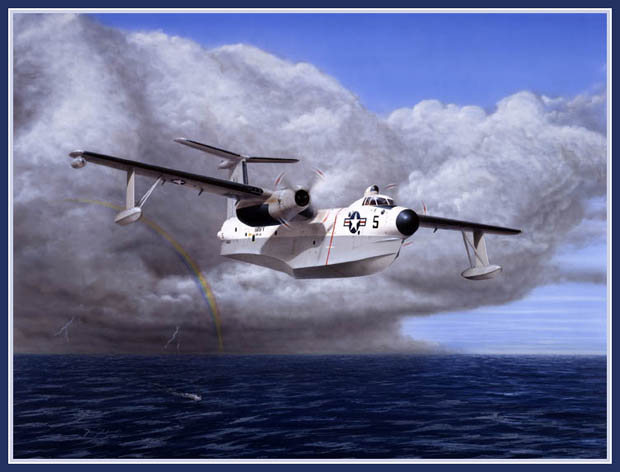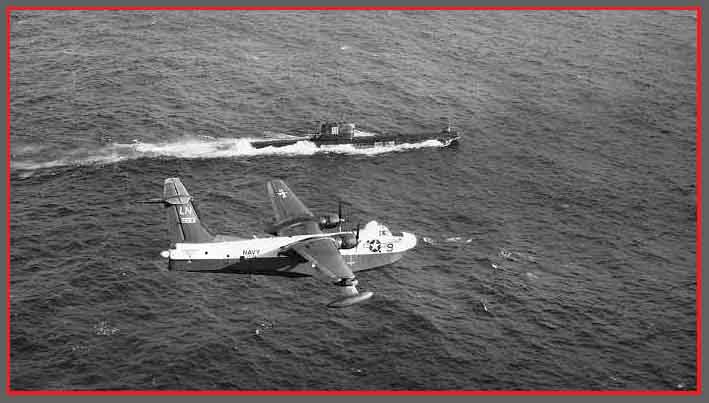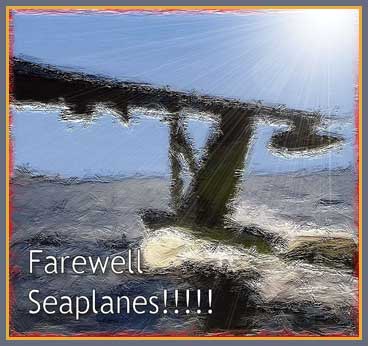













"Marlin's Milieu" An Original Painting by Don Feight
Patrol Squadron Forty-Five commenced the much awaited transition to the P5M-1 (SP5A) in 1954 with twelve crews and new aircraft. The squadron completed its transition to the P-5M under CDR W. T. Luce, who was CO until January 1955. Not many people remember that Costa Rica and Nicaragua had a war in the mid-50’s, but those who were in VP-45 then sure do. The squadron flew many missions over both countries during the conflict for the Organization of American States (OAS) surveillance of the fighting. Those in the squadron then also remember trying to get appliances such as radios and fans to work in the 25 cycle AC current at Coco Solo. Light bulbs flickered and fans ran at double speed trying to make their 60 cycle motors operate with  25 cycle current. Only AC/DC radios would work, it has been said. Tropical working hours were great for the married folk-Morning Muster was at 0700 and Secure was 1300 daily during the weekdays. Possibly the longest endurance flight in a P5M was performed by VP-45 around this time when one plane stayed airborne for 21.8 hours and landed with about 2 hours of fuel. One plane was lost when it mysteriously dropped off the tail gear while being towed, and bent very badly in the middle.
25 cycle current. Only AC/DC radios would work, it has been said. Tropical working hours were great for the married folk-Morning Muster was at 0700 and Secure was 1300 daily during the weekdays. Possibly the longest endurance flight in a P5M was performed by VP-45 around this time when one plane stayed airborne for 21.8 hours and landed with about 2 hours of fuel. One plane was lost when it mysteriously dropped off the tail gear while being towed, and bent very badly in the middle.
In 1955 sister squadron VP-34 moved to Coco Solo from Trinidad with its PBMs, and subsequently was disestablished. Many of those squadron members were assimilated into VP-45. In both 1955 and 1956 VP-45 spent the summers in Corpus Christi as part of the NARMID operation - the orientation of Naval Midshipmen to the aviation branch of the Navy. While in Panama the bottoms of several "boats" were painted with several different formulas and left in the buoy patch for days to test whether barnacles would grow on them. Junior officers and bachelor crewmen got in a lot of fishing, but the tests were inconclusive. In April 1956, the squadron was involved with the submarine Guavina off the coast of Florida investigating the feasibility of refueling seaplanes in the open sea. CDR W. J. Denholm relieved CDR Luce in January 1955 and was relieved by CDR E. W. Pollard in March 1956. While at NARMID that year, the squadron’s homeport was changed back to Bermuda, and the move was completed in September of 1956.

With a mixture of P5M-1 and 2 aircraft, VP-45 shared the seadrome at Bermuda with VP-49 and participated in deployments with seaplane tenders and conducted the usual operational and training flights. CDR H. E. Sorenson became the Commanding Officer in April 1957 and was relieved by CDR S. A. Thomas in April 1958. In 1958 the squadron set a SPRINGBOARD record for total flight hours and, on a flight from BDA to JAX, one aircraft set a dubious record for water taxiing a couple hundred miles to JAX after engine failure.
From this point, the history is relatively incomplete. Several past Skippers and other shipmates have provided what follows, so excerpts from the Change of Command brochures and letters will have to do until we can pry the official history from Navy archives. Note that at some point while the squadron flew P-5's, the tail letters were changed from "EE" to "LN." The L was likely meant to mean "Lant" (for Atlantic Fleet) and the second letter was assigned in squadron nemeric order. So VP-5, the lowest number Atlantic fleet P-3 squadron, became LA and VP-56, the highest number squadron became LQ.
CDR H. M. "Bull" Durham relieved CDR Thomas in March 1959, and three months later the squadron deployed again to NAS Corpus Christi for NARMID ‘59. A total of 816 hours of classroom instruction was combined with 1400 hours of flight time for the period. Under CDR Durham a total of 440 flight hours were accomplished while operating with USS Albemarle (AV-5) in the Virgin Islands in a 10 day period, flying the Caribbean from Trinidad to Guantanamo. CDR Durham was relieved by CDR E. P. Palm in March 1960. CDR A. S. Lee was next in line from March ‘61 to March ‘62, and was then followed by CDR G. R. O’Bryan who commanded until relieved by CDR J. R. Chappell in March 1963. Until the end of 1962, VP-45 took part in every Mercury SPACE SHOT as part of the Bermuda Recovery Unit, indoctrinated NROTC and USNA Midshipmen in Seaplane Aviation, and became part of ASW Task Group DELTA in September 1961 whose mission was "...to realize the full potential of ASW aircraft." At the end of 1962 VP-45 left DELTA to deploy to Guantanamo Bay, Cuba for ASW and shipping surveillance during the Cuban Missile Crisis.
March ‘62, and was then followed by CDR G. R. O’Bryan who commanded until relieved by CDR J. R. Chappell in March 1963. Until the end of 1962, VP-45 took part in every Mercury SPACE SHOT as part of the Bermuda Recovery Unit, indoctrinated NROTC and USNA Midshipmen in Seaplane Aviation, and became part of ASW Task Group DELTA in September 1961 whose mission was "...to realize the full potential of ASW aircraft." At the end of 1962 VP-45 left DELTA to deploy to Guantanamo Bay, Cuba for ASW and shipping surveillance during the Cuban Missile Crisis.
The period under CDR Chappell saw the last of the seaplane flying for VP-45, the earning of the Battle Efficiency ‘E’ for 1963 and the CNO Safety Award.
Send questions, comments or suggestions regarding this website to: vp45association.org
Copyright © 2005 PATRON FOUR FIVE ASSOCIATION